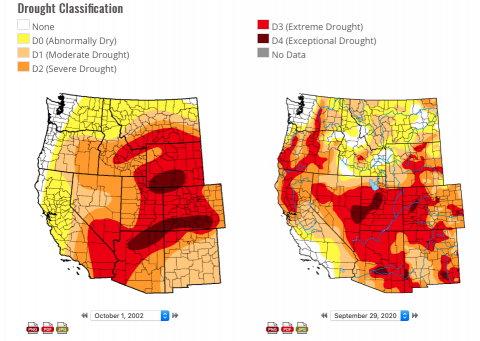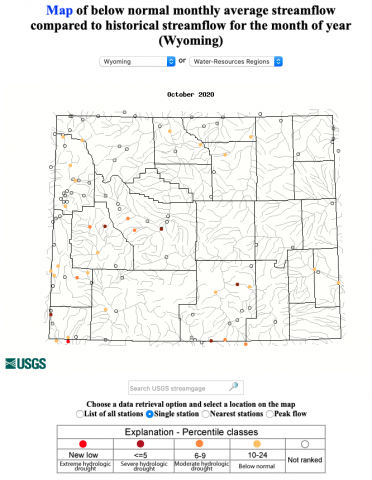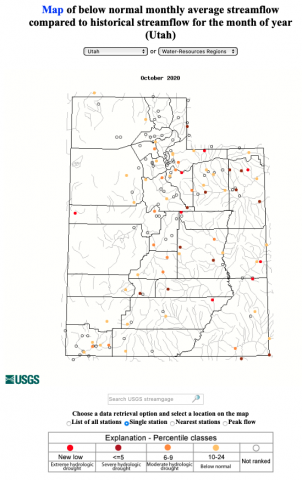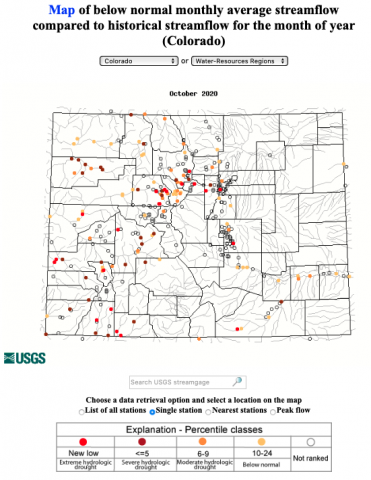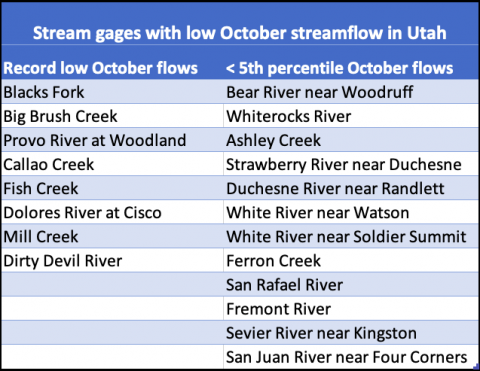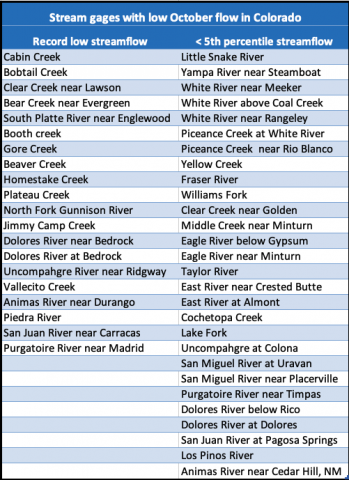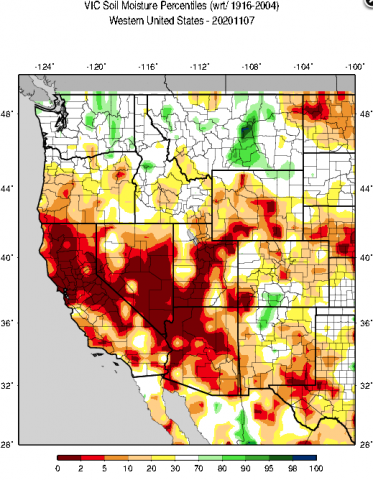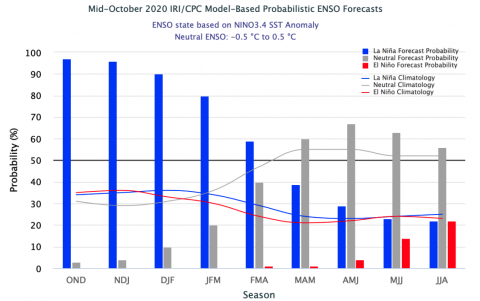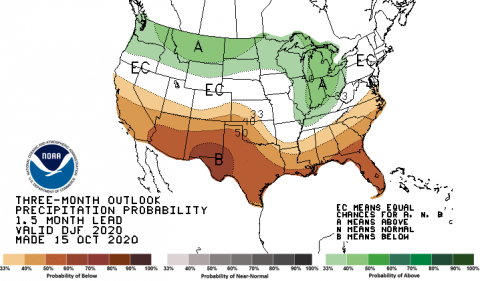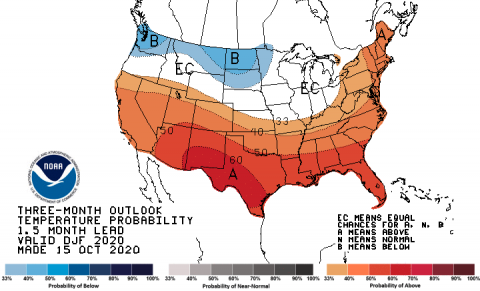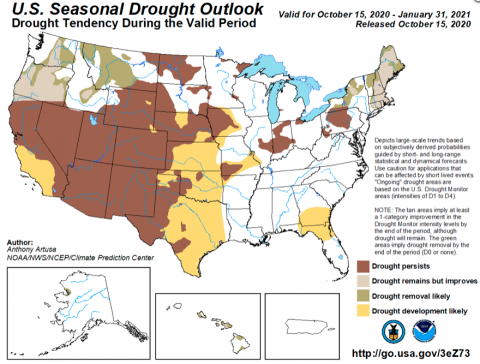Water Year 2021 Outlook (UT, WY, CO)
-
Current climate conditions and seasonal forecasts suggest that the 2021 water year is likely to be drier than average for much of Colorado, Utah and Wyoming. At the start of the 2021 water year, much of the region is under extreme or exceptional drought (D3-D4), soil moisture is extremely low and streamflow is at all-time or near-all-time lows at many locations. Extremely dry conditions to begin the 2021 water year mean that spring runoff will almost certainly be an inefficient runoff, where a normal snowpack would yield a below normal seasonal runoff volume. La Niña conditions currently exist and are extremely likely to continue this winter. La Niña typically delivers below normal precipitation to southern Colorado and Utah and above normal precipitation to northern Wyoming.
-
Since 2000, only the drought of 2002 caused a worse start to a water year than the current drought. As of October 1st, 2020, extreme (D3) drought covers 48% of the region and exceptional (D4) drought covers 5% of the region. In 2002, D3 drought covered 59% and D4 drought covered 19% of the region, respectively. Wyoming and Colorado were significantly drier in the 2002 drought compared to the 2020 drought, but Utah is experiencing drier conditions now compared to 2002.
-
Streamflow across the region is very low and record to near-record low monthly streamflow was observed at 71 stream gage locations in October 2020. Streamflow was relatively closer to normal in Wyoming during October; near-record low streamflow (< 5th percentile) was observed at three sites. During October, streamflow was below normal at the majority of sites in Utah. Record low October streamflow was observed at eight sites and near-record low streamflow was observed at 12 sites including the Provo, Bear, Duchesne, Sevier and San Juan Rivers. In Colorado, record low October streamflow was observed at 20 stream gages and near-record low streamflow was observed at 28 sites. Major rivers with record low October streamflow include the Animas, Dolores, North Fork Gunnison, San Juan, South Platte and Uncompahgre Rivers.
-
Soil moisture conditions in October 2020 are an indicator of both current drought conditions and potential efficiency of 2021 spring runoff. Soils across the Intermountain West are extremely dry to start the 2021 water year. At the beginning of November 2020, record low soil moisture was observed across much of Utah including the Wasatch and Uinta Mountains. Soil moisture in about half of Colorado was very low (< 10th percentile) and record low soil moisture was observed in the San Juan Mountains. Soil moisture in northern Wyoming was near-normal to start the water year, but much of the southern two-thirds of the state saw very low soil moisture (<10th percentile).
-
Moderate La Niña conditions currently exist and there is an 85% probability of La Niña conditions persisting throughout the winter and a 60% chance of La Niña conditions lasting through spring. In the western United States, La Niña conditions typically bring a higher probability of wetter conditions to the Northwest and a higher probability of drier conditions to the Southwest. The precipitation outlook for December – February shows a 40% probability of above average precipitation in northern Wyoming and 40% probability of below average precipitation in southern Colorado and Utah. There is a 40-50% probability of above average temperatures for Colorado, Utah and southwestern Wyoming during December – February.
-
So what does this all mean for water availability in spring and summer 2021? Let’s first discuss the aspects of the 2021 water year that are certain: current conditions. The current drought is very bad throughout the entire region, but it is most severe in Utah and Colorado with respect to October soil moisture and streamflow. Because of very dry conditions, it is very likely that runoff will be inefficient in 2021 and seasonal runoff volumes will be lower relative to average compared to April 1st snow-water equivalent (average snowpack leads to a below average runoff). Extremely dry soil moisture conditions prior to the development of winter snowpack lead to an inefficient runoff because water from melting snow in the spring must first wet dry soils before it enters streams. All portions of the region are likely to see an inefficient runoff except for northern Wyoming. Areas that are most likely to have lower seasonal runoff compared April 1st SWE include the Dolores, Duchesne, Provo-Jordan, Sevier, San Juan and Virgin River basins.
-
There is less certainty in the amount of precipitation that will fall and the amount of snowpack that will accumulate. However, a higher probability of below average precipitation in southern Colorado and Utah suggest that snowpack in much of the Upper Colorado Basin, especially in the Dolores, Gunnison and San Juan River basins may be below average. A higher probability of above average winter temperatures in Colorado and Utah suggest a below average low elevation snowpack. The combination of dry conditions entering the 2021 water year and La Niña conditions contribute to the likely persistence of regional drought conditions through early winter. Northern Wyoming has the best chance of an above average snowpack due to an increased probability of above average precipitation and equal chances of above or below normal winter temperatures.
-
There is an increased probability of below average seasonal runoff volumes in Colorado and Utah in 2021. The greatest chance of low seasonal runoff volumes is in southern Colorado and southern Utah where October conditions were very dry and there is an increased probability of below average precipitation. The Dolores, San Juan, Sevier and Virgin River basins are at the most risk of reduced seasonal runoff volumes in 2021. There is an increased chance in the Upper Green River basin for above average April 1st SWE and near-normal seasonal runoff volumes. Due to the severity of regional drought entering the 2021 water year, seasonal runoff volumes are likely to be lower compared to average than April 1st SWE for nearly the entire region.
